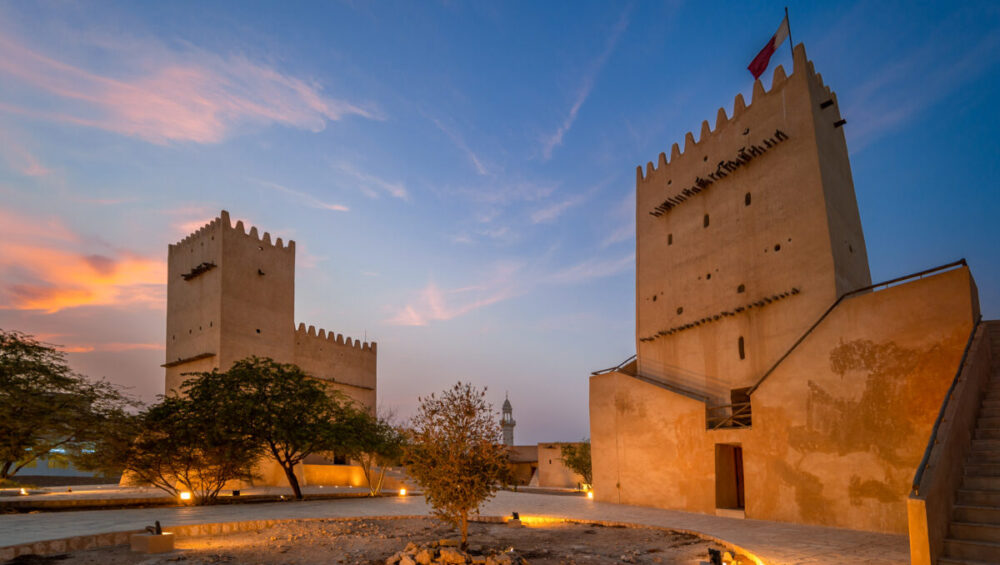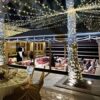If you are looking for a glimpse into Qatar’s rich history and culture, the Barzan Towers are a must-visit destination. Umm Salal Mohammed, Qatar, is home to several towers that have come to represent Qatar’s rich history. These towers are an impressive representation of Qatari design and have a rich and exciting history.
This article offers a guide for potential visitors to the Barzan Towers, including the towers’ history, architecture, and significance.
History of the Barzan Towers
The backstory of the Barzan Towers begins in the late 19th century and is fascinating. The towers were constructed during the early 1900s when Qatar was a significant center for pearl digging. This sector, one of the most lucrative in the area, was crucial to the country’s economy.
The necessity for safety measures increased alongside the development of the pearl diving industry. The guards in the Barzan Towers were given a commanding view of their surroundings thanks to their strategic placement. The pearl diving industry relied on them as a watchtower as well. The towers also allowed the locals to send and receive smoke signals with one another.
The towers’ three stories were constructed from limestone and coral and housed various amenities. The basement was utilized for warehousing, while the family occupied the above floors. The top floor served as a communication hub and vantage point.
The towers’ strategic value declined as new technologies emerged over the 20th century. The buildings had been left unattended and had fallen into disrepair when the government of Qatar began a restoration project in 2006. In 2008, after years of renovation, the towers were reopened to the public.
The Barzan Towers are a popular destination for visitors today, and they serve as a reminder of Qatar’s long and illustrious cultural history. The towers’ rich history and the traditional Qatari building techniques utilized to construct them can be explored by curious sightseers. The Barzan Towers are a stunning architectural achievement and an essential stop for any tourist interested in Qatar’s heritage.
Architecture and Design
The Barzan Towers are essential to Qatari history and represent classic Qatari design. Limestone and coral, both quickly accessible in the area, were used to construct the towers. The towers’ ability to vanish into their natural settings directly results from using these materials.
The complex carvings and decorations on the towers are among their most striking characteristics. These patterns reflect the high level of craftsmanship and artistic sophistication that permeated the era in which they were built. The people of Qatar have a lot of imagination and creativity based on these carvings.
Each of the tower’s three stories serves a different function. The first floor housed a warehouse, while the second housed the guards’ quarters and families. The third and highest floor was employed as a watchtower because of its commanding vantage point.
These Towers are a practical example of traditional Qatari architecture and an impressive architectural achievement in their own right. Dry-stone masonry and lime mortar, which have a long history in the area, were employed to construct the towers.
The towers’ historic architecture and complex embellishments are now on display for tourists. These towers, lovingly restored to their former splendor, stand as a testament to Qatari history and tradition. Anyone interested in history, architecture, or the aesthetic value of handiwork owes it to themselves to visit the Barzan Towers.
Significance of the Towers
The Barzan Towers have great symbolic and cultural significance for the people of Qatar. The towers were an essential first line of defense for the surrounding towns and the pearl diving industry. They were a crucial part of the area’s defense system and a necessary component of the region’s infrastructure.
Additionally, the towers symbolize the fortitude and creativity of the Qatari people. The people of Qatar overcame many obstacles to build this formidable fortress from scratch using only native resources and time-tested methods. The towers symbolize the ingenuity, hard work, and ingenuity of the individuals who constructed them.
Visitors worldwide go to see the Barzan Towers because of its increasing fame in recent years. The towers attract foreign visitors and Qataris interested in the country’s rich heritage and architectural traditions. The buildings represent Qatar’s long and illustrious history and stand as a testament to the country’s cultural wealth.
Restoration and Preservation
In recent years, there have been ongoing restoration attempts to keep the Barzan Towers standing for its historical and cultural value. Maintenance has focused on fixing damage from regular use and protecting the towers from the severe desert environment.
The towers’ authenticity to their original design has been preserved through painstaking restoration efforts that have employed time-honored construction methods and locally available materials. These initiatives aim to protect the towers so that they can serve as a symbol of Qatar’s cultural heritage for years to come.
Modern amenities and equipment have been installed as part of the restoration work to make the towers more visitor-friendly. Visitors will be able to know more about the towers’ rich history thanks to the addition of walkways, viewing platforms, explanatory signs, and audio guides.
Visitor Information
Visiting the Barzan Towers is a great way to experience Qatari history and culture firsthand. To make the most of your visit, here is some practical information to keep in mind:
How to Get There
The Barzan Towers are located in Umm Salal Mohammed, about a 30-minute drive from central Doha. If you need to get your transportation, taxis are readily available and can take you directly to the site.
Admission Fees
Admission to the Barzan Towers is free for all visitors.
Opening Hours
The towers are open to visitors daily from 8:00 am to 5:00 pm.
Accessibility
The Barzan Towers are accessible to visitors of all ages and abilities. However, due to the steep stairs and narrow passageways, visitors with mobility issues may need help navigating.
What to Expect
The Barzan Towers will take you back in time to a simpler, more elegant era. You can go up in the towers and look at the beautiful scenery below while learning about its history and significance. The towers’ imposing height and width will immediately catch your eye as you approach the site. The buildings are perched on a hilltop, providing stunning vistas in every direction. The best view of the city and the surrounding desert may be had from the top of the guard tower.
By exploring the towers, you can imagine what life was like for the guards who once lived there. You can see the guards’ quarters, where they slept and ate, as well as the watchtower from which they kept an eye on the neighborhood. This is interesting for more than just cultural and historical reasons; the Barzan Towers, for example, are named after a now-extinct indigenous people group. In addition, each tower has over 40 individual rooms and is over 100 feet.
It’s worth noting that the charisma and attraction of the Barzan Towers have been featured in a number of films and television series.
Things to Do Near the Barzan Towers
In addition to the Barzan Towers, tourists have several other options for things to do in the surrounding area. The Umm Salal Mohammed Fort is one such site that may be found not far from the twins. The sheiks of Umm Salal Mohammed made the fort their home in the early 20th century.
Conclusion
The Barzan Towers are a significant landmark in the cultural history of Qatar. The towers’ renovation has kept them open to the public and protected their historical value. The Barzan Towers are an essential part of Qatari history, and they also serve as a remarkable architectural feat. So, if you love to explore Qatari Culture, Plan your tour to the Barzan Towers today!




